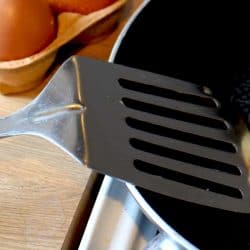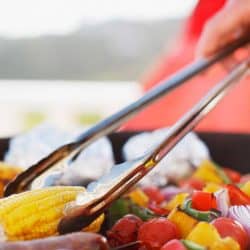![Kitchen utensils in containers on table, Kitchen Utensils: The Ultimate List [Do You Know All 56?]](https://kitchenseer.com/wp-content/uploads/2020/05/Kitchen-Utensils-The-Ultimate-List-Do-You-Know-All-56.jpg) Utensils lay the groundwork of any functioning kitchen because without any utensils, you cannot prepare or serve even the simplest of meals. You are probably most familiar with the types of kitchen utensils that we use to eat our food like knives, forks, and spoons. But, did you know there are numerous other types of utensils that help us prepare ingredients and serve various foods and beverages?
Utensils lay the groundwork of any functioning kitchen because without any utensils, you cannot prepare or serve even the simplest of meals. You are probably most familiar with the types of kitchen utensils that we use to eat our food like knives, forks, and spoons. But, did you know there are numerous other types of utensils that help us prepare ingredients and serve various foods and beverages?
Knowing about different types of utensils is essential so you can select the best utensils for your preferred cooking and baking techniques and serving style. So, we’ve prepared this thorough list of all the kitchen utensils for you to learn what is available and how each kitchen utensil works.
Types of Kitchen Utensils
Contents
Spatulas
A spatula is used for spreading, scraping, lifting, and mixing foods. It has a flat, flexible head made from either rubber, silicone, nylon, or stainless steel.
1. Spoon Spatula
The slightly cupped head of this spatula resembles a spoon. The wide surface area of a spoon spatula is useful for scraping and scooping ingredients. Use a spoon spatula for layering ingredients, like when making a lasagna or filling a cake.
Click here to find this on Amazon.
2. Scraper Spatula
One curved edge of a scraper spatula is used to gently gather ingredients as you scrape. Use a scraper spatula along the inner edges of bakeware, mixing bowls, pots, and pans to remove bits of food, batter, and liquids.
Heat-resistant scraper spatulas are helpful to use as you cook soups, stews, and sauces to prevent the edges of the food from burning on pots and pans.
Click here to find this on Amazon.
The narrow head of a jar scraper spatula fits neatly into narrow jar openings and small food storage containers. It’s helpful to remove the last remnants of the container, so no food goes to waste. Jar spatulas are also an excellent utensil to scrape the inner edges of your blender or food processor as you prep ingredients.
Click here to find this jar spatula on Amazon.
3. Mixer Spatula
The tapered head of a mixer spatula is shaped for ease of lifting and folding together ingredients. Use a mixer spatula to stir and fold meringues, airy cake batters, and souffles. It can also double as an omelet turner.
Click here to find this on Amazon.
4. Cake Spatula
Cake or icing spatulas have a thin, elongated stainless steel head available in lengths ranging from 4” to 12.” Angled cake spatulas are slightly more rigid compared to straight cake spatulas.
Click here to find this on Amazon.
Cake decorators choose their preferred cake spatula based on how comfortable it is to use. By using a cake spatula, you can spread an even coat of icing on the top and sides of a cake with just a few brief strokes.
Click here to find this on Amazon.
Spoons & Ladles
Spoons and ladles prove useful utensils in your kitchen for transferring, serving, mixing, and measuring foods. These utensils are available in a variety of materials like stainless steel, silicone, nylon, and wood, depending on their use.
1. Serving Spoon
The serving spoon is a large, 8.5” to 10” utensil with a broad, deeply cupped head. It is used to scoop out and serve food from a communal dish. When used for dining table service, the style of the serving spoon compliments that of your flatware.
Click here to find this on Amazon.
When used either for buffet service or to plate food served from the kitchen, a serving spoon has a more commercial look. Use a serving spoon for foods like mashed potatoes, rice, casseroles, vegetables, and puddings.
Click here to find this on Amazon.
2. Slotted Serving Spoon
A slotted serving spoon is used to scoop out and serve foods from a liquid. The slots in the head of the serving spoon let the liquid drain through to stay behind in the pot or bowl, so you just lift the solid food.
Use a slotted serving spoon to serve foods like steamed vegetables and fruit salads. While cooking, a slotted spoon is especially useful to remove boiled foods from water and fried foods from grease.
Click here to find this on Amazon.
3. Ladle
A ladle is used to transfer and serve food by lifting both the solid and liquid simultaneously from either a pot or serving bowl. The ladle has a long, angled handle to let you easily reach into tall stockpots. The bowl-shaped head of the ladle is deeper than that of a spoon, so spills are less likely to occur as you transfer food.
Ladles come in a variety of lengths and head sizes to accommodate an assortment of pot heights, serving bowl depths, and food portion sizes. Large 9” to 15” ladles are useful for serving soup, stew, sauce, and punch. Smaller 5” to 8” ladles are useful for serving gravy, dressings, and condiments.
Click here to find this on Amazon.
4. Pasta Ladle
Also referred to as a spaghetti server, the pasta ladle is equipped with fork-like spokes and sieve-like holes. The spokes make it easier to grab a hearty portion of slippery noodles while the holes let water drain from the pasta. Most pasta ladles are heat resistant, so you can submerge the head and handle into boiling water.
Click here to find this on Amazon.
Want to add pizazz to your pasta with freshly grated cheese? Check out our blog, “12 Types of Graters [And How to Use Them].”
5. Wooden Spoon
Distinctly stylish, a wooden spoon adds a rustic look to your kitchen. Available with various handle lengths ranging from 10” to 14,” the wooden spoon has a wide, yet shallow cupped head.
Wooden spoons require a bit of extra care because wood is a soft material prone to scratches, cracks, and splintering. Avoid using wooden spoons over direct heat. Hand wash wooden spoons.
Click here to find this on Amazon.
6. Sauce Ladle
The sauce ladle has a convenient pour spout, so you can pour liquids in a steady stream without an unforeseen splatter occurring mid-serve.
Use a sauce ladle to serve tomato sauce, cream sauce, punch, and gravy. Sauce ladles are available in a variety of sizes to accommodate your kitchen’s cookware and serving-ware.
Click here to find this on Amazon.
7. Berry Serving Spoon
Traditionally fashioned in silver, a berry spoon has an intricately designed head. Imprints of fruits and berries adorn the cupped center bordered by a scalloped rim.
The scalloped rim prevents berries from rolling off as you scoop from a serving bowl or plate. Berry spoons range from 9” to 12” in length, ideal serving plentiful portions.
Click here to find this on Amazon.
8. Measuring Spoon
Get the exact amount of ingredient whenever you use a measuring spoon. Gathered as a set, each measuring spoon holds a specific teaspoon or tablespoon quantity. Head shape can be round or oblong. Use measuring spoons for wet and dry ingredients.
Click here to find this on Amazon.
9. Basting Spoon
The shallow basting spoon is made from heat-resistant material. A long handle lets you easily reach the spoon into hot pans and bakeware.
Use a basting spoon while you cook. Intermittently scoop drippings from the bottom of the pan to pour the liquid over the top of foods. Basting helps to keep foods moist as they cook.
Click here to find this on Amazon.
10. Vegetable Spoon
A vegetable spoon is typically the largest spoon in your set of flatware. You might also hear it referred to as a tablespoon or serving spoon. The 8” to 9.5” length handle extends to a broad, cupped head. A vegetable spoon is intended for serving vegetables and other sides from communal dishes at your dining table.
Click here to find this on Amazon.
11. Salad Spoon
A salad spoon has a long, 9” to 12” handle and shallow cupped head with a forked end. The forked end helps to poke and grab loose lettuce pieces from deep serving bowls.
Typically, a salad spoon is paired with a serving spoon as a set. Use the set together for salads to snatch ingredients up between the two utensils. Separate the utensils for individual use to serve from multiple dishes.
Click here to find this on Amazon.
12. Magnolia Ladle
Handcrafted in the shape of a blooming magnolia, this ladle becomes an accent piece on your dining table. The 12.5” magnolia ladle is an excellent utensil for serving punch and sauces.
Click here to find this on Amazon.
13. Powdered Sugar Spoon
A baking utensil, the powdered sugar spoon has a broad, fine mesh head that lets you dust confectioner’s sugar over your pastries, candies, custards, and cakes. Angled 7.5” handle is comfortable to hold for an evenly spread dusting.
Use the powdered sugar spoon to dust other ingredients like cocoa powder, cinnamon, and nutmeg, atop sweets, and beverages.
Click here to find this on Amazon.
14. Precision Spoon
Teardrop-shaped head with a tapered spout lets you decorate foods and serving plates for an exceptional presentation. The 8” handle is well balanced, so you can accurately pour, drop, and drizzle oil, dressing, sauce, chocolate, and syrup. Use the precision spoon to add final touches to your dish just prior to serving.
Click here to find this on Amazon.
Whisks
Whisks have a cage-like head formed by multiple, bent over wires that extend from a sturdy handle. The head of a whisk is made from either stainless steel or silicone. Handle materials vary, with some being comfort grip handles. The most commonly used whisk has a head shaped like a light-bulb or a balloon.
Use a whisk to add volume to foods. Rapid whisk strokes will either emulsify, beat, or whip ingredients together. A balloon-shaped whisk is versatile, but different shaped whisk cages can prove handy for specific uses. Whisks come in a variety of sizes to best accommodate your cooking techniques.
1. Flat Whisk
A flat whisk is an ideal utensil for making a roux, gravy, and lemon curd. Because it is flexible, this whisk can easily skim the edges of a saucepan or skillet to incorporate all the ingredients while you stir. You can also use a flat whisk to remove fried foods from oil. An 8” to 11” handle keeps your hands clear of the heat while you cook.
Click here to find this on Amazon.
2. Jug Whisk
A slim version of a balloon type whisk, the jug whisk’s narrow cage-like head can easily fit into tall, narrow containers. Use the jug whisk to mix drinks and dressings in pitchers and jugs.
Click here to find this on Amazon.
3. Egg Whisk
An egg whisk is a miniature 4” to 6” version of a balloon type whisk. The smaller size makes the egg whisk ideal for making scrambled eggs, beating egg whites, and mixing eggs for an omelet. You can also use an egg whisk to make whipped cream and meringue.
Click here to find this on Amazon.
4. French Whisk
The French whisk is essentially a steadfast version of the commonly used balloon-shaped whisk. The cage-like head is constructed from thicker wires with a tapered shape. Use a French whisk for sauce, batter, vinegarette, custard, and mayonnaise.
Click here to find this on Amazon.
5. Sauce Whisk
Also referred to as a spiral whisk, the circular coil shape of a sauce whisk prevents stuck-on food at the bottom of your saucepan. The whisk head is rigid to remain in contact with the bottom of the pan as you stir. Use a sauce whisk for gravy and sauces like ragu and Alfredo.
Click here to find this on Amazon.
6. Speed Whisk
Get the efficiency of a blender by using a semi-automatic speed whisk. By pushing down on the hand-held whisk, the spring-loaded head spins into action. Speed whisks save you time and energy. Use a speed whisk to beat eggs and emulsify liquids.
Click here to find this on Amazon.
Tongs
Extend your hand by using a set of 8” to 12” tongs to reach food over gaping griddles and stovetops. Tongs protect you from the heat to pick up and maneuver hot food. The tightly gripping ends of tongs can be made from wood or heat-resistant stainless steel, nylon, or silicone.
1. Nylon Head Tongs
Nylon is a heat-resistant, non-stick material. When used on the ends of tongs, semi-flexible nylon grips food with ease. It will not damage either metal or non-stick pots and pans.
Similar tongs can also be tipped with either silicone or rubber. These materials are of food-grade quality. Silicone is the most durable and can sustain the highest temperatures for handling hot foods.
Click here to find this on Amazon.
2. Turner Tongs
Turner tongs have broad ends, ideal for handling large cuts of meat like pork chops, steaks, burgers, and fish fillets. Both types of coiled spring tongs and scissor tongs can be designed with turner ends.
Click here to find this on Amazon.
You might prefer to use combo turner tongs, with one turner end and one grasping end.
Click here to find this on Amazon.
3. Stainless Steel Tongs
Simplistic stainless steel tongs are slim, durable, and lightweight. Operate scissor tongs by holding comfort grip handles between your fingers and thumb to open/close the tongs as you open/close your hand. Ends of manual tongs are equipped with protuberance for grip.
Click here to find this on Amazon.
Operate coiled spring tongs by holding between your fingers and thumb to press closed and release open gently. Some coiled spring tongs have a locking feature to keep tongs in the closed position. The edges on the ends of coiled spring tongs are scallop-shaped for grip.
Click here to find this on Amazon.
4. Toast Tongs
Do not risk burning your fingertips when you reach into the toaster. Instead, use a narrow pair of toast tongs to grab your toast.
Toast tongs are also handy to use as a serving utensil to pick up small, lightweight foods from a platter like crackers, cheese, and vegetables.
Click here to find this on Amazon.
5. Spaghetti Tongs
Also referred to as pasta tongs, comb-like ends are used to latch onto slippery noodles to serve pasta.
Click here to find this on Amazon.
6. Waffle Tongs
Uniquely shaped, the ends of waffle tongs use one forked end and one turner end to gently lift hot waffles from a waffle maker.
Click here to find this on Amazon.
7. Roast Cutting Tongs
Immense, 11.5” tongs secure your roast like a vice so you can make cuts without the roast slipping out from beneath the knife. Wide gaps between forked ends let you cut even slices by placing the carving knife between the gaps.
Click here to find this on Amazon.
Looking for the right pair of tongs for heavy lifting? Check out our blog post, “Top 10 Heavy-Duty Kitchen Tongs”
Turners
Kitchen turners let you maneuver food atop hot surfaces while you cook by lifting, flipping, and pressing flat. You might also hear these utensils referred to as flippers and spatulas.
Turners have a wide, flat head with one or more beveled edges. Turners are made from thin, heat-resistant materials like stainless steel, silicone, and nylon. A 10” to 14” handle keeps your hands and arms clear of hot cooking surfaces.
1. Solid Turner
Slide a solid turner beneath food to lift the entire portion at once. Solid turners can be used with virtually any food, but are useful for crumbly foods like crab cakes, home-fries, ground meat, scrambled eggs, and baked goods.
Click here to find this on Amazon.
2. Slotted Turner
Slotted turners are advantageous for lifting foods out of drippings because the slots let the liquid drain off as food is removed from the pan. Use a slotted turner for meats, fried foods, and sautéed or roasted vegetables.
Click here to find this on Amazon.
3. Omelet Turner
The flexible head of an omelet turner can glide effortlessly between an omelet and the sides of a pan. Loosen the omelet from the pan and then gently fold and flip by using the turner’s wide edge.
Click here to find this on Amazon.
4. Restaurant Turner
Ultra-thin, stainless steel restaurant turners are elongated to let you quickly maneuver sizeable portions of food from any angle. The beveled edges can both slide beneath and chop foods. The solid restaurant turner can maneuver foods of various textures on the same griddle without having to change utensils in-between.
Click here to find this on Amazon.
5. Burger Turner
Burger turners are solid and rigid so that your loaded burger does not collapse when removed from the griddle.
Click here to find this on Amazon.
6. Flexible Slotted Turner
Get beneath food even when it is up against the edges of a pan by using a flexible slotted turner. The flexible head bends to get beneath food in tight spaces, yet remains sturdy enough to lift food. Slots allow liquids to drain from the food.
Click here to find this on Amazon.
7. Easy Entry Turner
Because the head is angled away from the handle, an easy entry turner gives you a level approach to food even when reaching over the side of a pan. It has a beveled leading edge for ease of sliding under food without breaking food apart.
Click here to find this on Amazon.
8. Stiff Turner
The head of a stiff turner does not bend, and rather it is angled away from the handle to give you a level approach to food without contorting your wrist, elbow, or arm for leverage. It has a beveled leading edge for ease of sliding under food.
Click here to find this on Amazon.
9. Flat Pancake Turner
Either slotted or solid, a flat pancake turner mimics the circular size and shape of a pancake. Flat pancake turners are typically flexible, so you have better leverage to get beneath a pancake.
Click here to find this on Amazon.
10. Egg Turner
Egg turners are flexible, solid turners with a taper to curved top edge.
Click here to find this on Amazon.
11. Fish Turner
A fish turner is a variation of a flexible, slotted turner. The elongated head widens at the end and is made from very thin, slightly curved stainless steel. A fish turner flexes so you can get beneath and lift delicate fish fillets in one piece. Slots let drippings drain from the fish.
Click here to find this on Amazon.
12. Lasagna Turner
Lasagna turners are flexible and slotted so that excess sauce can drain from the lasagna slice as you remove it from bakeware.
Click here to find this on Amazon.
13. Grilling Turner
Extra-long handles of grilling turners keep you at a safe distance from the heat while maneuvering food on a grill. Grilling turners can be either slotted or solid. Some are equipped with additional features like a toothed edge for cutting food or a bottle opener.
Click here to find this on Amazon.
Other Food Preparation Utensils
1. Skimmer
Typically made from stainless steel, a skimmer is the shape of a ladle with a long handle and fine mesh, bowl-shaped screen. Use a skimmer to skim grease and foam from the top of simmering liquids.
Click here to find this on Amazon.
2. Asian Strainer
Also referred to as a spider, the Asian strainer is used to remove food from boiling water and hot oil. The Asian strainer is in the shape of a ladle with a long handle and wire bowl-shaped basket.
Click here to find this on Amazon.
3. Pastry Server
Triangular, just like a piece of pie, the pastry server has a pointed head that widens toward the handle to hold a slice of dessert. Some dual-purpose pastry servers have a serrated edge used to cut the dessert prior to serving.
Click here to find this on Amazon.
4. Baster Brush
It looks like a paintbrush, but the durable silicone bristles of a baster brush are heat-resistant. Use a baster brush to baste savory roasts with drippings and sweet pastries with butter. Basting gives your food a golden brown finish.
Click here to find this on Amazon.
5. Ice Cream Scoop
Hold on to a comfortable, contoured handle while you powerfully scoop ice cream with one steady pull. Ice cream scoops do not bend or break as they carve through ice cream to roll out a perfect scoopful. As a multipurpose utensil, use an ice cream scoop to serve sorbet, custard, and melon.
6. Pizza Wheel
A pizza wheel has a sharp, stainless steel blade that rotates behind a protective thumb guard. By applying gentle pressure as the wheel glides across a pizza, the blade will effortlessly cut through toppings and crust.
Click here to find this on Amazon.
7. Masher
The thick, stainless steel wire pattern of a masher resembles a fist pressing downward. As the name implies, mashers are used to smash food into a paste-like consistency. Use a masher to make mashed potatoes, guacamole, and mashed squash.
Click here to find this on Amazon.
8. Pizza Rocker Knife
The pizza rocker knife has a curved, 14” length blade. Situated across the diameter of an entire pizza, make a cut by rocking the blade back and forth. A pizza rocker also works great to efficiently and symmetrically cut cakes, cookie bars, and blocks of cheese.
Click here to find this on Amazon.
9. Sandwich Spreader
A sandwich spreader is a multipurpose utensil to be used both as a condiment spreader and knife. It has an oblong shape with one serrated edge. Use a sandwich spreader to prepare bagels, muffins, and toast too.
Click here to find this on Amazon.
10. Dough Scraper
The square-edged blade, either plastic or metal, of a dough scraper, is used to manipulate dough and to scrape clean your working surface afterward. A contoured handle lets you work comfortably. You can also use a dough scraper to measure portions and chop foods.
Click here to find this on Amazon.
11. Granny Fork
This versatile kitchen utensil goes by many names, including a kitchen fork and carving fork. It has a steadfast handle and two or three-pronged fork end. Use the granny fork to toss foods, pierce foods for maneuvering, and securely hold a roast while carving.
Click here to find this on Amazon.
12. Plating Brush
Easy to grip handles, let you work flawlessly with a plating brush to create decorative presentations. Silicone plating brushes can be used with hot and cold ingredients. Shaped tips like saw, angle, raised arch, and comb let you generate artistic designs in oils, sauces, and syrups.
Click here to find this on Amazon.
Get your kitchen fully equipped now that you know about all the different types of kitchen utensils.





















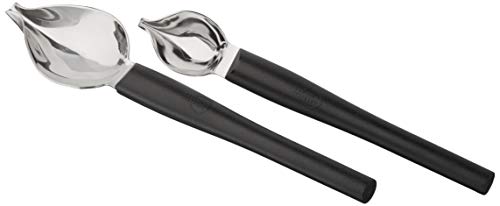

























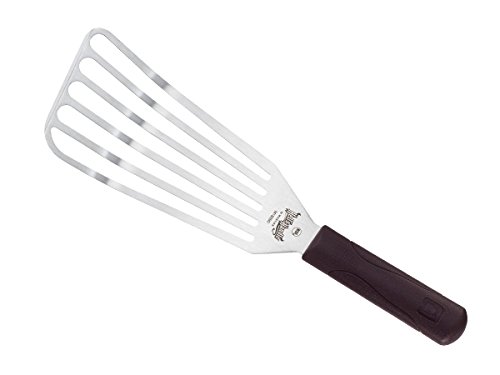











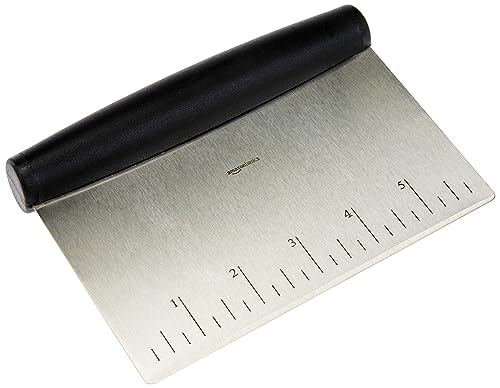


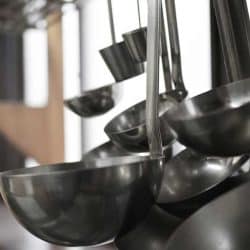
![Man holding tong while mixing her Japanese style ramen dish, Types Of Kitchen Tongs [And What They're Used For]](https://kitchenseer.com/wp-content/uploads/2020/05/Man-holding-tong-while-mixing-her-japanese-style-ramen-dish-250x250.jpg)
![man hand holding silver laddle . A type of spoon used for soup, stew, or other foods, How Much Does A Ladle Hold? [Sizes Explored]](https://kitchenseer.com/wp-content/uploads/2021/07/man-hand-holding-silver-laddle-.-A-type-of-spoon-used-for-soup-stew-or-other-foods-250x250.jpg)
